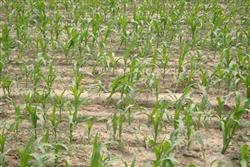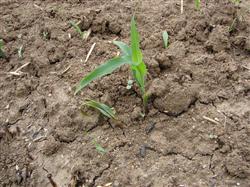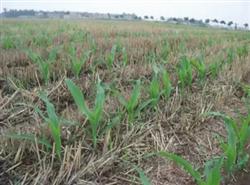How to manage summer corn seedlings well

How to manage summer corn seedlings? Please give guidance on the management of summer corn from emergence to jointing stage as seedling stage. The main characteristics are as follows: the aboveground part grows slowly and the root system grows rapidly. At this stage, the central task of field management is to promote root growth, cultivate strong seedlings, and lay the foundation for high yield. Maize seedlings are sensitive to environmental conditions, untimely or improper management, easy to form large and small seedlings, weak seedlings and diseased seedlings. Therefore, the seedling management of maize is very important, and comprehensive management measures should be taken. First, check seedlings, replenish seedlings after the emergence of corn seedlings, should immediately check seedlings, replenish seedlings. Before the 3-leaf stage of maize, it is found that there are more than 3 consecutive seedlings (holes), so the seedlings should be replenished in time, and the method of transplanting seedlings with soil can be adopted to reduce the difference of seedling potential between the adjacent plants and the adjacent plants. Transplanting should be carried out in rainy days or sunny afternoons, and watering should be carried out in time after planting to shorten the slow seedling time and ensure survival. If there are less than 3 seedlings (holes), leave two plants on one side or both sides of the missing seedlings, and there is no need to replant. Replanting is generally not recommended. The effect of replanting is not as good as replanting, and replanting is better than keeping two plants. Second, interseedling, fixed seedling suitable time seedling and fixed seedling are the key to reduce the rate of weak plants, improve the population uniformity and ensure the suitable density. Corn grows fast, so it should be timely and early to plant and fix seedlings. Generally master 1 to 2 leaves time seedlings, 2 to 3 leaves when the seedlings are fixed. The principle of inter-seedling is to get rid of weak seedlings and leave strong seedlings, and get rid of diseased seedlings to keep healthy seedlings. The time of inter-seedling and fixed seedling should be carried out in the afternoon of sunny day, because at this time, diseased seedlings, insect bites and stunted seedlings are easy to wilt, which is easy to identify and eliminate. The seedlings with dense dwarf leaves, thick at the bottom and fine at the top, and twisted silk-black spikes should be eliminated thoroughly. In dry land and plots with low production level, seedlings should be planted early and fixed. For plots with heavy diseases and insect pests, seedlings should be fixed at night. The distance between two seedlings was 5~10cm when two seedlings were retained. Interplanting corn has many insect pests, many disabled seedlings and heavy grass damage, so it is difficult to protect seedlings. Generally, there are 2 time seedlings with unfolded leaves and 3-4 fixed seedlings. Third, squatting seedlings to promote strong squatting seedlings is an effective technical measure to artificially control up and down according to the growth characteristics of maize seedlings, so as to solve the contradiction between aboveground and underground growth. It includes a set of measures to control watering, ploughing and deep hoeing and rooting, promoting the root development in depth, shortening the lower internodes of the stem, reducing the ear position and enhancing lodging resistance. At the same time, promote panicle differentiation, effectively alleviate the contradiction between aboveground and underground, vegetative growth and reproductive growth, and lay the foundation for large panicles and more grains. Corn squatting seedlings should be flexibly controlled according to variety, density and soil fertility. Generally, strong seedlings with dark green leaves, fertilizer, high density and sufficient moisture should be used for squatting seedlings; weak seedlings that do not squat yellow and thin, thin and dry. Therefore, there is a peasant proverb of "three squats and three no squats", that is, "squat black without squatting yellow, squatting fat without squatting thin, squatting dry without squatting wet". Squatting seedlings should generally start from the seedling stage and end before jointing, the time is too short and ineffective, too long affects the differentiation of young spikes and forms "small old seedlings". At the end of squatting seedlings, fertilizer and watering should be applied immediately to promote growth. Interplanting corn sowing growth conditions are poor, generally not squatting seedlings, but should do a good job of water and fertilizer management to promote the weak to become strong. Fourth, ploughing, stubble killing and weeding is an important measure for maize seedling management. According to the study, the secondary roots of the second tillage in the seedling stage increased by 5% and 6, the root depth increased by 6~7cm, and the yield increased by about 10%. Generally, the seedlings are ploughed for 2 to 3 times, and the first time is in the depth of 3~5cm before setting the seedlings, when the seedlings are short, it is necessary to avoid pressing and injuring the seedlings. The second and third time is from seedling setting to jointing stage, and the depth of 10cm is about. The principle of middle ploughing is: shallow ploughing next to seedlings and deep ploughing between rows. The seedling stage of direct seeding corn coincides with the rainy season and needs shallow ploughing. If the ploughing is too deep, the soil stores too much water, which is easy to cause sprout waterlogging or seedling waterlogging. After interplanting corn and wheat harvest, we should immediately plough and destroy stubble, loosen the soil and promote the development of root system. Fifth, topdressing and topdressing at seedling stage has the functions of promoting root, strong seedling, promoting leaf, strong stem and so on. Generally, it is carried out from the seedling setting to the jointing stage. The specific time of topdressing should be determined according to seedling condition, soil fertility and so on. Three types of seedlings, transplanting seedlings, plots without base fertilizer or seed fertilizer, low-lying, moist plots and interplanting plots, etc., should be pursued early and re-fertilized before and after seedling setting, and the plots with strong seedlings, high soil fertility and sufficient seed fertilizer can not or less. In addition to the application of chemical fertilizer, mature organic fertilizer can be applied. The amount of topdressing at seedling stage, in principle, all phosphate and potash fertilizer should be applied, and the amount of nitrogen fertilizer topdressing should be determined according to soil and seedling conditions. In general, 20%-30% of the total nitrogen is applied in high-yield fields, 50%-60% in middle-yield fields, and more than 60% in low-yield fields. Topdressing is generally applied in ditches or holes. The depth of 5cm is above, and that of seedling is above 10cm. Be careful not to burn the seedlings. Organic fertilizer should be deeply applied with 10cm. Sixth, the main pests in maize seedling stage are ground tiger, armyworm, aphid, thrips and so on. (1) Prevention and control of land tigers. After emergence, use 2.5% enemy to kill 800mm 1000 times liquid, spray seedling line in the evening, or 0.05% poisonous sand on both sides of seedling line. (2) Prevention and control of aphids. 40% dimethoate emulsion 1000-1500 times liquid, spray seedling heart. 1000 times, such as 40% omethoate EC or 50% malathion EC or 25% imidophos EC. It can also treat pests such as thrips, Swedish stem flies and planthoppers. (3) Prevention and control of armyworm. The second generation armyworm is harmful to interplanting corn and the third generation armyworm is harmful to summer direct seeding corn. It can be sprayed with 90% crystal trichlorfon or 40.7% Lesbon EC 1000-1500 times, 20% quick-killing butyl EC or 50% phoxim 1500-2000 times. (4) Control of corn borer and corn ear worm (cotton bollworm, sorghum stripe borer, etc.). 1, heart leaf stage: 1.5% phoxim granule 0.5kg, add fine sand 6~8kg, or BT emulsion 150ml 200ml, mixed with fine sand 5kg, or 1% 1605emulsion granule (50% 1605EC 0.5kg + water 10kg dilution, mixed with fine sand 25kg), heart leaf. The heart leaves can also be perfused with 1500 times diluted by 90% crystal trichlorfon or 800-1000 times by 50% dichlorvos emulsion. 2. Heading stage: 2000 times liquid of 90% crystal trichlorfon sprayed male ear, or 40% omethoate EC 40 times 60 times or 50% monocrotophos EC 20 times 50 times solution coated lower stem, and treated aphids. 3. After pollination, the female ear was drip irrigated with 2.5% dioxin oil 400 × 500 times or BT emulsion 200 times 300 times. 7. disease control of maize seedling disease is mainly caused by Pythium, Fusarium moniliforme, seedling blight and root rot. (1) sudden collapse. 10% Shilaoshi water agent, 50kg seed medicine 50g 100ml seed dressing, or 5% Genbao seed dressing. When seedling wilt disease leaves or wilt plants are found, 72.2% Purek water agent 500 times 800 times solution, or 58% Remicol-manganese zinc wettable powder 500 times solution, or 72% Kelou wettable powder 600 times solution can be sprayed. (2) Leaf spot. 40% gram distemper powder or 70% mancozeb wettable powder 600 times liquid spray. (3) small spot disease. 50% carbendazim wettable powder 500 times liquid, or 70% methyl topiramate wettable powder 500 times liquid spray. (4) viral disease. At the initial stage of the disease, 20% virus nemesis 500 times liquid and Luyebao 400 times 500 times liquid were sprayed together, which had a certain effect. It can also be sprayed with 1500 times of omethoate EC or 2500 times of 50% aphid-repellent wettable powder to control aphids and gray planthoppers and eliminate virus-transmitting insects. Click to get more corn planting techniques click to get more food crop planting techniques
- Prev

What should be paid attention to in summer corn seedling stage
What should summer corn seedling stage pay attention to? Please introduce the following points to be done at the seedling stage of summer corn: first, check seedlings to replenish seedlings and prevent seedling deficiency and broken ridges in order to ensure the whole seedling, seedlings should be checked and replenished in time, replanted with precocious varieties after sprouting or before the age of 4 or 5 leaves of the seedlings. Transplant seedlings with soil in the afternoon or in cloudy days. Corn is 3 kilos.
- Next

Which diseases and insect pests need to be controlled in summer corn seedling stage?
Which diseases and insect pests need to be controlled in summer corn seedling stage? Please introduce the control methods of summer corn seedling stage, there are the following diseases and insect pests need to be controlled: 1, seedling pest control corn seedling main pests are: armyworm, cotton bollworm, gray planthopper, thrips, Swedish flies and so on. 5% cypermethrin and 2.5% chlorine can be used to control armyworm and cotton bollworm.
Related
- The first cup of black tea in spring, the flavor and history of tea gardens in Kenya, Africa
- The computer can not only choose potatoes, but also grow tea rice. AI will grow winter oolong tea champion.
- It is not only the inflated tea bitten by insects, but also engraved with the four seasons tea in Beipu.
- The Oriental Beauty Tea Festival in Zhuxian County takes the stage at the weekend to experience the plus-size feast of oil tea.
- & quot; Oriental Beauty Tea & Exploration of Emei in Hsinchu, the hometown of quot;
- The new variety of strawberry "Tainong 1" dessert is the first choice with mellow aroma. Crimson gorgeous
- History of Tea in Taiwan: from Wild Inner Mountain to Export Tea Garden
- Two types of Taiwan Oriental Beauty Black Tea won the British three-Star Award for Childhood Tea Xiang Zhang Jiaqi changed from pilot to champion tea maker.
- Banana species and varieties: the planting history of Taiwan Xianren banana and dwarf banana is long, is banana disease resistant?
- Coffee planting Technology: Qianjie Coffee from Seedling to harvesting

